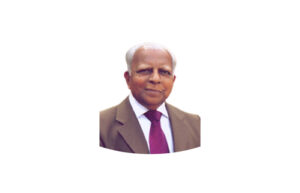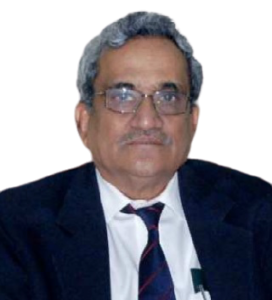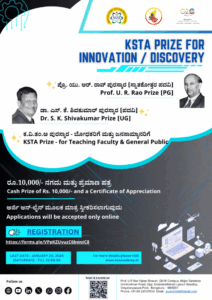Creativity
10 min readProf. J. R. Tonannavar
Former Chairman, Dept of Physics
Karnatak University, Dharwad-580 003
email: jtonannavar.kud.phys@gmail.com
And
Prof. B. G. Mulimani
Member, KSTA and Former Vice Chancellor,
Gulbarga University, Kalaburgi
email: bgmulimani70@gmail.com
It is said we must owe an undying debt of gratitude to the Man who first invented ‘the wheel’ because the invention, as it were, imparted a momentum to the creation of civilizations. The modern Man as Homo sapiens is 100,000 years old and yet his evolution through the years is a testimony to creative traits acquired by him. Were it not for the evolution, the modern Man might not have split off from his nearest cousins – Chimpanzees. The wheel may be the first manifestation of the man’s urge to self-express, a trait induced by evolution, sharpened and fashioned in time, which he handed down to his successors. The ‘fittest species’, according to Darwinian theory of evolution, are those who acquire traits to continue to evolve while others fall by the way-side. If birds have built nests, men have built civilizations, created art, religion and culture. So, for Man, creativity must have been both the survival tactics and fundamental impulse of joy and value. According to the Cambridge dictionary, creativity is ‘the ability to produce or use original and unusual ideas’. Creativity can be nurtured or cultivated; it can lead to discoveries, inventions and innovations. Is it the sole prerogative of talented people? Mark Twain says, ‘Really great people make you feel that you, too, can become great’. Scholars, artists, politicians, writers, scientists, technologists and even lay-persons are creative though the nature, intensity and influence of creativity vary widely: what the technologist creates could impact the society more widely than the lay-person’s but still the lay-person’s creativity, however small, is still of value. While the technologist invents to meet a greater challenge, the artist creates a painting of enduring value, the farmer, say, solves a problem he faces on farm. While what all these three vocations create are of value, they differ in their impact. It is, of course, also true that geniuses have great and revolutionary minds, the stamp of being genius is uniqueness in creativity or creative thinking. For example, Mahatma Gandhiji and social reformer Basaveshwara were spiritual geniuses; the Greek scholar Plato enhanced Man’s love of wisdom; the Catholic canon and Renaissance astronomer Copernicus’ notion of the Sun-centered solar system changed our world-view; Shakespeare’s narratives in his plays touched our emotional intelligence; and naturalist Darwin showed what profundity as to the descent of Man can be unraveled from nature by the keen observation. In the present essay, we look at how creativity has influenced Man to satisfy his urge, to create civilizations and to advance his knowledge. The expanse of creativity is vast; therefore, we restrict ourselves to arbitrarily selected areas of Man’s endeavors to analyze our essay.
Art in all of its forms created cultures; Man’s urge to know his origin and destiny created religion; Science, as we all know, is a recent human endeavor to understand nature in an impersonal way. At the deepest level, nature is beautiful and has a strong intellectual appeal; at the practical level, Man is overwhelmed and empowered by the scientific knowledge he has acquired. At the core of what Man has achieved in art, religion and science, we assume, lies his ‘creativity’. Today the scientist and technologist have a fair understanding of nature’s processes, and as a result, they have become, among others, drivers of the modern civilization. ‘Scientific research’ says an American scientist E. Bright Wilson, ‘not being a routine process but requiring originality and creative thought, is very sensitive to the psychological state of the scientist’. German polymath Hermann von Helmholtz describes three stages of creativity, ‘saturation, incubation, illumination’. To this French scientist Henry Poincare adds, ‘verification’, for new ideas need to be verified. Given these four stages, scientists still differ by the form and effectiveness of their creativity. Thus we broadly identify some aspects we believe are involved in creativity: vision, formulation, solution and unified picture. In what follows we will examine these aspects by illustrations.
During the 19th century, the laws underlining electricity and magnetism were discovered by different scientists without ‘seeing’ common threads running through them. It was James Maxwell, the most distinguished scientist at the University of Cambridge, who imagined a larger and unified picture of all these phenomena and showed all the laws are derivable from his electromagnetic theory. Further, he showed light radiations are electromagnetic waves originating in the oscillations of electric and magnetic fields. Although he did not discover any of the laws, Maxwell envisioned seemingly different electric and magnetic phenomena as a single unified manifestation of the electromagnetism. This is arguably the highest form of creativity in science. Modern communication technologies, among others, emanate from the electromagnetic theory. Another of the 19th century British naturalist Charles Darwin, who was no prodigy in any sense, made observations of animals and plants, collecting and sifting a large body of their fossils, remained pensive for a number of years, and finally arrived at a profound theory underlying the myriad forms of life on planet Earth. From simple forms of life from the earliest times, he argues, both animal and plants have evolved into complex patterns, driven by the natural selection in which those adapted to change survive while others go extinct. Darwin’s grand vision summarized in his classic book the Origin of Species, exacted subtleties from nature’s handiwork spread over millennia.
As Chemistry became scientific during the 19th century with the advent of successive atomic theories, the Periodic Table of Elements became its precursor. It was the Russian chemist Dmitri Mendeleev whose dream created the Periodic Table. He reminisced about the incidence, ‘I saw in a dream a table where all elements fell into place as required. Awakening, I immediately wrote it down on a piece of paper, only in one place did a correction later seem necessary’. As he put all the known elements into unique positions based on chemical properties in the Table, Mendeleev was led to the prediction of the new elements, germanium, gallium and scandium. In the Mendeleev story, all the four stages mentioned above, have occurred: after the saturation of his mind with the idea, the incubation followed resulting in illumination as a dream and finally the Periodic Table was born and verified. The Periodic Table today is the bedrock of modern Chemistry. It is not necessary for creativity to be always a means to an end; it may be an end in itself. This may be seen in the great work of the 20th century mathematicians A.N.Whitehead and Bertrand Russell who demonstrated that all mathematical statements are reducible to symbolic logic and their joint work produced three-volume books called Principia Mathematica. Later another eminent mathematician Kurt Godel showed by way of his famous discovery ‘Incompleteness Theorems’ that such a reduction of all mathematics to a consistent system of symbolic logic is not provable because the system entails unprovable statements. While the Principia Mathematica was hailed as a magnum opus by many, after Godel, it was also described as a monumental failure! Purists, however, argue that the Whitehead-Russell duo’s work inspired advances in symbolic logic and philosophy of mathematics. At any rate, their creative work remains of value, so to speak, just like the pure form of art.
If we deviate from science and look at other dimensions of creativity, literature affords a very good example. Many scholars through the generations have rewritten the stories of Ramayana and Mahabharata, adding form and substance while keeping the spirit intact, yet all of it constitutes a creative work. While creativity runs through all societies, its pursuit to promote new political or religious thought leads to upheavals, reforms and more often meets with resistance from the corridors of power. Mahatma Gandhiji’s spiritual genius led a political movement with non-violence as its core principle. As Gandhiji struck the right chord in the hearts of millions of fellow Indians, the British Empire had to quit India. While he is described as ‘the prophet of non-violence since Lord Buddha’; in the political history of the world, Gandhiji is a greatest statesman and a genius; in moral philosophy, he remains exemplary.
The old adage, ‘Necessity is the mother of invention’ promotes creativity as the successive Industrial revolutions are testimony to it. Western societies are prosperous because they are highly creative, enabling them to make newer technologies and sell them. Secondly, their liberal political system is favorable to creative pursuits in all spheres of human endeavors. However, where creativity is suppressed by the authoritarian regimes, societies tend to numb intellectual progress as evident in histories. The greatest Italian scientist of the 17th century, Galileo, dared the authority of Roman Catholic Church, laying down scientific method for testing observations and hypotheses. He made many fundamental discoveries in physics and astronomy and finally he said, ‘the Earth moves around the Sun’ which challenged the Aristotelian world-view. The pro-Aristotelian Pope of the Church jailed Galileo for his bold assertion with a warning to other men not to indulge in such advocacies. The Church was successful because for a long time, Italy did not see men of Galileo’s eminence.
One creative idea can produce another one with potential impact. At the time of inventing an electron microscope in the early 1930s, a young German engineer Ernst Ruska learnt that the electrons have a wavy motion just like light waves. The idea came from the French physicist Louis de Broglie who had put forth that electrons also behave as waves whose wavelength varies inversely as their velocities. By lowering the velocities of the electrons, Ruska attained wavelengths by five orders of magnitude shorter than light waves. This led him to the invention of the electron microscope with an ability that surpassed the conventional optical microscope. Forty years later Ruska was honored with a Nobel Prize in physics! Interestingly, Louis de Broglie’s concept too was an extended concept due to Einstein who put forth that light wave behaves as a stream of moving particles. If light wave has particle behavior, de Broglie’s argued that electrons as particles have wavy behavior. Both concepts are so fundamental that they are integral to our understanding of matter and energy. The two concepts, among others, advanced 20th century physics. Both Einstein and Louis de Broglie were honored with the Nobel Prize.
All through the human history, the kings and queens patronized creative people with state honors and entitlements, being equivalent of today’s academies and societies. There is flipside too, which is, creative works especially in arts, theology, political theories, economic policies produced against the establishment become the object of scorn or worst, they are suppressed. Prof.Wendy Doniger’s book, The Hindus: An Alternative History, was banned, much to the delight of some fringe groups. If a modern painting, however creative, has images even corresponding to the most respected ancient works, it is still rejected.
In the evolution of Indian civilization and culture, the discriminatory social system based on status, caste and gender was handed down to us through centuries. To remove the centuries old discrimination was by no means an easy task in those days since it was accepted as irreversible but normal being of the social structure. The task thus required a creative approach radically different from the prevailing system of beliefs deeply entrenched both in people’s psyche and practice. In the 12th century, the poet-philosopher-statesman Basaveshwara hailing from Basavan Bagewdi, a northern tip of Karnataka, propounded a new religious philosophy that broke away from the orthodox Vedic system. He replaced institutionalized religious practices with individual-centric ones in which the human body is equivalent of the temple, wearing and worshipping istalinga as deity. This can be practiced by all men and women regardless of their social status. Basaveshwara created an Anubhava Mantapa, the ‘Parliament of Spiritual Experience’, arguably unique in the human history, where he assembled men and women of all diverse socio-economic background for discussion on spirituality culled from their life, profession and intuitional experience. All of this movement inspired the men and women at the Anubhava Mantapa to create a Vachana literature rich in its principles churned from a profound understanding of man’s spiritual dimensions, his relation to God and Nature. All this culminated in the birth of Linagayat religion. He equated vocation with the attainment of a spiritual bliss, which he expressed by way of his famous line, Kayakave Kailas, being roughly translates into ‘Work is Worship’. While Basaveshwara’s benevolent but creative deed stirred up the social conscience leading to ‘a social revolution’ and making him ‘a forerunner’ of social reformation, he suffered a religious persecution at the hands of the state. Whatever, since then many men and women have been inspired by his thought, and we as a nation still strive for an inclusive society.
We ask the same questions again: can creativity be taught? Or is it innate trait or influenced by environment? While these questions can be debated, if we put them in the context of the prevailing education system we see its undue emphasis on knowledge acquisition through formal instruction which by its design cannot inspire creativity in children. Creativity outside the formal system should also be recognized and mentored. Mathematical genius Srinivasa Ramanujan as a student had no interest whatsoever in studying subjects other than mathematics and therefore failed to earn a degree. It was the eminent mathematician G.H.Hardy of Cambridge University, who recognized Ramanujan’s genius and mentored him. What is more, brushing aside systemic hurdles, Hardy got Ramanujan elected as a Fellow of the Royal Society, a great professional honor at the age of 31. While this example cannot be extended to all situations but there is a lesson to follow: if creativity is to be nurtured, it must remain free and informal since formal education systems meet the needs of an egalitarian society and thus cannot effectively nurture it. Unfettered creativity as a value of the human culture is to be respected since it is inherently spiritual; in so far as it is worldly, it is to be nurtured for the advancement of civilization.
In this essay we have shown by way of instances how ‘creativity’ advances knowledge, produces technology and enhances human culture. However, there are many questions which, in a forthcoming article, we propose to discuss including ‘how to think like a genius’; how creativity unfolds in the backdrop of history, cultural milieu, the influence of knowledge domain and gene-gift paradigm association.






